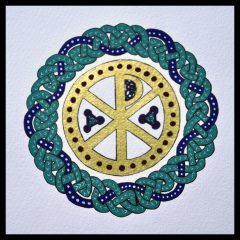
For a printable copy of this chapter (1) click here: 8.5×11″; A4 paper
Click here for a pdf of Genesis 4–11 in Redemptive History: 8.5×11″; A4 paper
.
.
b) Rev 6:11: For people in Greco-Roman culture, clothing represented a person’s identity.[1]
In this verse, God responded to the martyr’s plea in Rev 6:9–10 symbolically, giving each of them a white robe. White robes denoted the purity which resulted from persevering in faith (Rev 3:4–5).[2]
This garb also connoted salvation, victory, and immortality.[3] Therefore, the Lord declared them righteous despite the world’s guilty verdict.[4]
.
.
Then these martyrs were told to “rest a little longer.”
God expects them to wait, even though his sense of time is not like ours (2 Pet 3:8).[5]
C. S. Lewis captured this concept well. When the Christ-figure told Lucy that he would return shortly, she asked, “Please, Aslan…what do you call soon?” He replied, “I call all times soon.”[6]
What the martyrs eagerly anticipate will occur when “might be completed also, [the number of] their fellow servants, their brothers [and sisters], the ones about to be killed even as they [had been].”
.
.
The apocryphal book of 1 Enoch expresses this same concept:
And in those days shall have ascended the prayer of the righteous, and the blood of the righteous from the earth before the Lord of Spirits. In those days the holy ones who dwell above in the heavens shall unite with one voice and supplicate and pray…that judgment may be done unto them…
In those days I saw the Head of Days when he seated himself upon the throne of his glory, and the books of the living were opened before him…
And the hearts of the holy were filled with joy; because the number of the righteous had been offered, and the prayer of the righteous had been heard, and the blood of the righteous been required before the Lord of Spirits.”[7]
.
.
The martyrdom of believers falls within the plan of God. Their deaths shall inaugurate the coming of the Kingdom in all its fullness,[8] making these Christians especially important in determining when the Lord returns.[9]
Nero’s victims in John’s era were soon followed by those who died under other Roman emperors.[10]
For example, Polycarp (ca. 69–ca. 155 AD), a disciple of John, refused to deny Christ by elevating Caesar above the Lord.[11]
Shortly before his persecutors burned him to death, he testified, “Thou hast granted me this day and hour, that I might receive a portion amongst the number of martyrs…May I be received among these in Thy presence this day, as a rich and acceptable sacrifice.”[12]
May we stand as firmly as Polycarp did, through whatever trials we undergo.
Image via Wikimedia Commons
.
Read Rev 6:11. Why were the martyrs given white robes and told to wait a little longer? How do their deaths affect the timing of Christ’s return? What gives you the ability to stand firm under great pressure?
.
.
.
Go to Cursed from the Ground (Gen 4:11‒14)
[Related posts include Pleading for Justice (Rev 6:9‒10); Clothed by God (Gen 3:21); Cain Arose against His Brother (Gen 4:8); Misappropriated Blood (Gen 4:9‒10); A Charge of Hypocrisy (Matt 23:29‒33); From Abel to Zechariah (Matt 23:34‒36); We Shall Be Changed (1 Cor 15:51–52); Clothed with Christ (Gal 3:26–27); The New Holy City (Rev 21:10–11); A Return to Paradise (Rev 22:1–5, 20); and Ancient Literature]
[Click here to go to Chapter 1: A Tale of Two Brothers (Genesis 4:1‒16)]
.
[1] Ulrich Wilckens, “στολη” (stolē), TDNT 7:687–91, 689.
[2] Beale, The Book of Revelation: A Commentary on the Greek Text, 394.
[3] Wilckens, “στολη” (stolē), TDNT, 7:691.
[4] Beale, The Book of Revelation: A Commentary on the Greek Text, 394.
[5] Keener, Revelation, 220.
[6]C. S. Lewis, The Voyage of the “Dawn Treader” (New York: MacMillan, 1952), 138.
[7]R. H. Charles, trans., “Book of Enoch,” in The Apochrypha and Pseudepigrapha of the Old Testament (APOT) (Oxford: Clarendon, 1913), 47, 90–2, https://archive.org/stream/cu31924067146773#page/n207/mode/2up.
[8] Aune, Revelation 6–16, 411.
[9] Beale, The Book of Revelation: A Commentary on the Greek Text, 394.
[10] Mounce, The Book of Revelation, 149.
[11]Bruce L. Shelley, Church History in Plain Language, 3rd Ed. (Nashville: Thomas Nelson, 2008), 37.
[12]Polycarp, The Martyrdom of Polycarp (trans. J. B. Lightfoot, adapted by Athena Data Products ; 1990), 14.2, https://archive.org/stream/apostolicfathers02lakeuoft#page/330/mode/2up.
